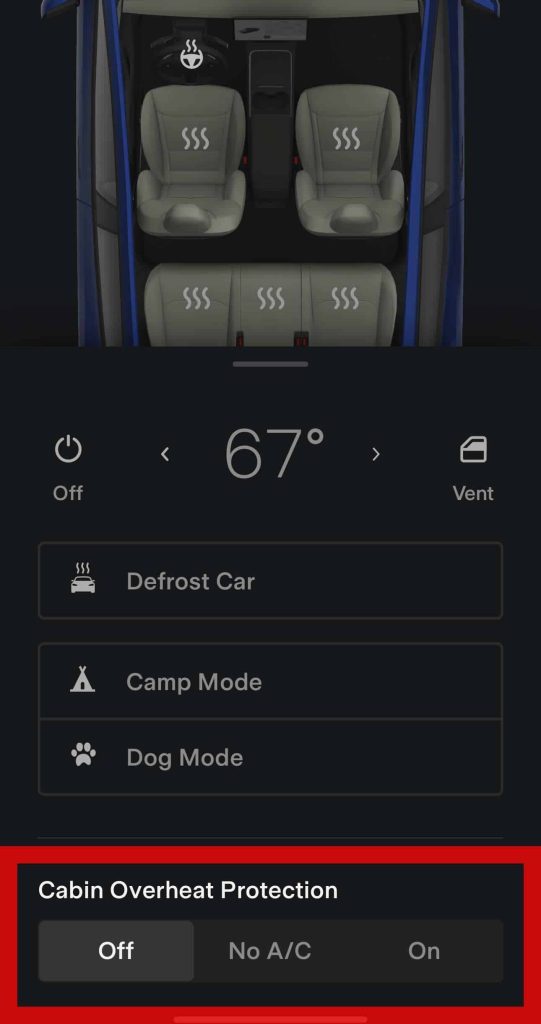Tesla Cabin Overheat Protection:
All Your Questions Answered
Tesla’s Cabin Overheat Protection system prevents your vehicle’s interior surfaces and personal belongings from becoming dangerously hot to touch, when parked in direct sunlight. Cabin Overheat Protection automatically begins cooling the vehicle when the interior temperature reaches 104° F (40° C), for up to 12 hours.
What is Tesla Cabin Overheat Protection?
Tesla Cabin Overheat Protection is a feature available in all Tesla vehicles that helps prevent the cabin and touch surfaces from getting too hot when parked in direct sunlight or extreme temperatures. It uses fans and/or air conditioning to reduce and maintain the temperature of the cabin when the interior temperature reaches 104°F (40°C), or a customized temperature.
Cabin Overheat Protection is designed to protect skin and personal items from dangerously hot temperatures – not to keep the cabin cooled for passengers or pets. Tesla Cabin Overheat Protection can be activated through the vehicle’s touchscreen or mobile app and programmed to turn on the air conditioning or just the fan.
Cabin Overheat Protection may take up to 15 minutes to enable once you exit the vehicle, and it operates for up to 12 hours after exiting the vehicle, or until the battery drops below 20%, whichever comes first.
How to Turn On Tesla Cabin Overheat Protection
There are two ways to turn on Tesla Cabin Overheat Protection:
- Using the touchscreen:
- Select Controls > Safety > Cabin Overheat Protection
- Choose one of the following options:
- On: The air conditioning automatically operates when the cabin temperature exceeds 104°F (40° C). Drivers can also set a customized temperature of 90, 95 or 100°F.
- No A/C: Only the fan operates to prevent touch surfaces from getting too hot.
- Select Controls > Safety > Cabin Overheat Protection
- Using the Tesla app:
- Tap on Climate
- Swipe up on the bottom menu and select a setting under Cabin Overheat Protection (On or No A/C)

Benefits of Using Tesla Cabin Overheat Protection
The Cabin Overheat Protection feature has both pros and cons. Here are the pros:
- Comfort: Cabin Overheat Protection can help reduce hot temperatures inside the cabin, making it more comfortable to enter after leaving the car parked in the sun.
- Safety: By preventing the interior from reaching dangerously high temperatures, Tesla Overheat Protection helps avoid burn injuries and protects personal items, such as phones and tablets, from potential heat damage.
- Pet Safety: If you need to keep your vehicle cool for a pet, we recommend using Dog Mode rather than relying on Cabin Overheat Protection.
Negatives of Using Tesla Cabin Overheat Protection
Tesla Cabin Overheat Protection has a few potential downsides that could influence whether you use this feature:
- Reduced range: Using Cabin Overheat Protection requires energy from the car’s battery, which can decrease your car’s range.
- Increased energy usage: Cabin Overheat Protection increases the energy usage of the car’s climate control system, which can further reduce your car’s range.
- Potential system failure: In some cases, the Cabin Overheat Protection system may not function properly, resulting in the interior of the car getting too hot. This is why it’s essential to activate Keep Mode or Dog Mode when leaving passengers or pets unattended in a parked car.
Can I Adjust the Temperature that Cabin Overheat Protection will Maintain?
You can customize the temperature at which Cabin Overheat Protection is activated by using the Tesla mobile app. Choose from 90°F, 95°F, or 100°F as the threshold for activation. Otherwise, your vehicle will activate Tesla Cabin Overheat Protection when the interior temperature reaches 104°F(40 °C). You cannot use Cabin Overheat Protection to set the temperature that you wish the vehicle to be maintained at.
If you’re looking for ways to keep your vehicle at a specific temperature, consider using Keep Climate On mode, Dog Mode, or Camp Mode, depending on your needs. These modes allow you to set specific temperatures for the cabin and are designed for different scenarios, such as keeping the car comfortable for pets, maintaining the climate while parked, or providing a pleasant environment for camping.
Does Cabin Overheat Protection Use a Lot of Battery?
Cabin Overheat Protection uses battery power to maintain a comfortable interior temperature, which can result in increased energy consumption. The exact amount of battery usage depends on several factors, such as the outdoor temperature, how long the feature is activated, and whether the air conditioning (or fan) is used.
Our Experience With Battery Usage
Based on our team’s observations, battery usage for Cabin Overheat Protection (with Air Conditioning) is around 0.75 kWh. In one instance, our consumption reached approximately 6 kWh over an 8-hour period during the daytime. That means our vehicle’s range dropped by about 12 miles. While this might not seem like a significant amount, it can impact your Tesla’s range if you rely on this feature frequently or for extended periods.
It’s important to be mindful of your Tesla’s battery usage when relying on Cabin Overheat Protection and other features like Sentry Mode. Both of these features consume battery power while your vehicle is parked, and using them simultaneously can lead to a more significant impact on your Tesla’s range.
To maximize your battery life and efficiency, it’s a good idea to evaluate your parking habits and determine if you need to use these features concurrently, or if you can rely on alternative strategies like parking in shaded areas or using window shades to keep your Tesla cool and secure.
How to Use Cabin Overheat Protection Efficiently: Top Tips
To optimize battery usage while keeping the cabin temperature comfortable, consider the following options:
- Use the “No A/C” setting. This setting only operates the fan and does not use the air conditioning system, thereby conserving battery life. However, it provides limited cooling compared to the full Cabin Overheat Protection feature.
- Park in shaded areas. Whenever possible, park your Tesla in shaded spots or covered parking to minimize the need for Cabin Overheat Protection.

- Use window shades. Installing window shades or sunshades can help keep the interior cooler and reduce the need for Cabin Overheat Protection.
- Window tinting. If you live in an area that regularly experiences high temperatures, consider having your Tesla’s windows tinted. Window tinting can significantly reduce the amount of heat entering the cabin by reflecting solar rays, which helps maintain a cooler interior temperature and lessens the need for Cabin Overheat Protection. Keep in mind that local regulations may have restrictions on the degree of tint allowed, so it’s essential to check and comply with those regulations before proceeding.
- Ensure that your vehicle’s software is up to date. Tesla frequently releases updates that can improve the performance of features like Cabin Overheat Protection.
How Long Will Tesla Cabin Overheat Protection Stay On?
Tesla Cabin Overheat Protection will stay active for up to 12 hours after you exit the vehicle. However, it will automatically turn off if the battery charge drops below 20% before the 12 hour period is over. This ensures that your vehicle’s battery isn’t excessively drained by this feature, which could impact the overall range and efficiency of your Tesla.
When planning to leave your car parked in hot, sunny conditions for an extended period, keep these time limits in mind. Also, remember to check your battery level and ensure that it is above 20% to take full advantage of the Cabin Overheat Protection feature.
Is Tesla Cabin Overheat Protection Necessary?
Keeping Cabin Overheat Protection off will not directly harm your Tesla. Still, prolonged exposure to high temperatures or sunlight can super-heat the interior, and potentially cause burn injuries or cause damage to personal belongings left in the car like smartphones, heat-sensitive electronics or makeup.
It’s also possible for extended heat and sunlight to dry out vegan leather seats over the long term, possibly leading to dulling and cracking. Leaving Cabin Overheat Protection off also raises the risk for potential injury due to extremely hot touch surfaces.
Tesla Overheat Protection vs. Dog Mode vs. Keep Mode
While Cabin Overheat Protection helps to cool your vehicle’s interior temperature and touch surfaces, it’s not specifically designed for pets or passengers. When leaving pets or passengers in a parked car, use Tesla’s Dog Mode or Keep Mode instead.
- Dog Mode maintains a comfortable temperature for your pet while displaying the current cabin temperature on the touchscreen so that passersby can see your pet is safe. Dog Mode is intended to be used for short periods and should only be used while staying close to your vehicle.
- Keep Mode maintains a set cabin temperature for passengers when the car is parked. Use Keep Mode when leaving passengers in your vehicle.
Why Use Tesla Cabin Overheat Protection?
Parking your Tesla in direct sunlight can heat the cabin rapidly, making the interior and touch surfaces uncomfortable or even dangerously hot to touch.
On a sunny summer day, your vehicle’s interior can reach 129 degrees (54 degrees C) in just 20 minutes. Touch surfaces (like steering wheels, seats and dashboards) get even hotter and can reach a scorching 157 degrees (70 degrees C), resulting in potential burn injuries.
First degree burn injuries can occur when skin touches surfaces at 118 degrees F (48 degrees C).
How the Sun Heats up a Vehicle: Greenhouse Effect
Interior heating is due to the greenhouse effect, where sunlight causes interior temperatures to rise dramatically, even if it’s not hot outside. Air gets trapped in the car under the glass and is then heated by the sun. Interior temperatures can rise quickly, even if the window is left open to vent.
The National Institute of Standards and Technology indicates potential injuries that can can occur when skin is exposed to heat, such as a vehicle’s interior cabin temperature.
| Conditions | Vehicle’s Interior Air Temperature | Potential Injury |
|---|---|---|
| Normal average body temperature | 98.6°F (37°C) | None |
| Cabin Overheat Protection Activates | 104°F (40°C) | None/mild discomfort |
| Parked in direct sun for 50 minutes (70° F outdoor temperature) | 111°F (44°C) | Pain |
| Parked in direct sun for 40 minutes (80° F outdoor temperature) | 118°F (48°C) | First degree burn injuries |
| Parked in direct sun for 50 minutes (90° F outdoor temperature) | 131°F (55°C) | Skin blistering & second degree burn injuries |
Touch Surfaces Get Even Hotter
Touch surfaces like seats, steering wheels and dashboards absorb even more solar heat than the ambient cabin temperature, making them soar to potentially dangerous levels.
For example, when parked in direct sun for 20 minutes (100°F outdoor temperature), interior touch surfaces can reach a dangerous level of 157°F (70°C), which can destroy human tissue if exposed for more than a few seconds.
Our Experience with Hot Interiors
Our team of real Tesla owners have had some unpleasant experiences with a too-hot interior – until we learned about Cabin Overheat Protection.
Thankfully, no serious injuries occurred, but some of our early experiences weren’t pleasant, including:
- leaving a tube of lipstick on the charging station (a gooey “Retro Ruby” mess)
- permanently damaging the battery on an iPad
- burning the back of the legs on a super hot seat (not a serious burn, but not pleasant)
EVPro Tip: If you can’t park in a shaded area, activate Cabin Overheat Protection – especially in hot weather or when traveling with children, pets or elderly adults that may not react quickly to touching hot surfaces.
FAQ
How do I turn off Tesla Cabin Overheat Protection?
There are two ways to turn off Tesla Cabin Overheat Protection:
- Using the touchscreen:
- Select Controls > Safety > Cabin Overheat Protection
- Select Off: Disables Cabin Overheat Protection
- Using the Tesla app:
- Tap on Climate
- Swipe up on the bottom menu and select a setting under Cabin Overheat Protection (Off)
Why is the Tesla Cabin Overheat Protection greyed out?
If the Cabin Overheat Protection setting is greyed out, it could be due to the following reasons:
- You’re not in Park: Cabin Overheat Protection can only be turned on when the car is in Park.
- The battery is below 20%: Cabin Overheat Protection will not activate if the battery is less than 20%. This is to prevent the battery from being drained completely.
What should I do if Tesla Overheat Protection doesn’t work well?
If Tesla Overheat Protection isn’t working well for you, consider using Tesla Keep Mode or Dog Mode instead. These modes are designed specifically for maintaining a comfortable temperature for pets and passengers when the car is parked.
Will not using Tesla Overheat Protection damage my vehicle?
Not using Tesla’s Cabin Overheat Protection feature is unlikely to cause any damage to your vehicle directly. However, if you frequently park your vehicle in hot temperatures or direct sunlight for extended periods, the interior of your car can get extremely hot, potentially causing damage to the materials and surfaces inside. High temperatures can cause plastics and vinyls to fade and crack over time, and can cause damage to vegan leather and other materials.
Will my Tesla app notify me when Cabin Overheat Protection is activated?
When your vehicle’s interior temperature reaches the limit you have specified, you will receive a notification on your app to alert you that the Cabin Overheat Protection has been activated.
Does the color of my Tesla affect the cabin temperature?
Researchers at the University of Wisconsin-Madison College of Engineering’s Solar Energy Lab, have found that the exterior color of the car’s interior does not have a significant effect on the interior temperature when a vehicle is parked directly in sunlight. However, lighter interior colors (like Tesla’s premium white vegan leather seats) will absorb slightly less solar energies, leading to a marginally cooler touch surface.
Do all Teslas have Cabin Overheat Protection?
All Tesla models have the Cabin Overheat Protection feature as part of their intelligent climate control system.
Dog Mode vs. Cabin Overheat Protection: Which is better for pets?
When considering the safety and comfort of your pets, it’s important to understand the differences between Tesla Dog Mode and Cabin Overheat Protection.
Dog Mode is specifically designed to keep pets comfortable in a parked vehicle. When enabled, it maintains a consistent, cool cabin temperature and displays a message on the touchscreen, informing passersby that the pet inside is safe. This mode is intended for short periods and should only be used while staying in close proximity to the vehicle.
On the other hand, Cabin Overheat Protection is designed to prevent the cabin from reaching dangerously high temperatures in sunny, hot conditions. While it can help keep the cabin slightly cooler, it shouldn’t be used for pets as it doesn’t provide the same level of temperature control as Dog Mode.
EVPRO TIP: If you need to leave your pet in the car for a short period, it’s best to use Dog Mode to ensure their safety and comfort. Remember that leaving pets unattended in a vehicle can be dangerous, especially in extreme weather conditions. Don’t leave anxious pets alone and check your app frequently to ensure Dog Mode is active and the cabin temperature is comfortably cool.
Camp Mode vs. Cabin Overheat Protection: Which is better for long-term parked stays?
Camp Mode is another useful feature for Tesla owners who want to maintain a comfortable cabin temperature during longer parked stays, such as camping trips or rest stops. Similar to the Keep Climate On setting (Keep Mode), Camp Mode maintains the cabin temperature while also allowing you to power electronics through USB ports and low voltage outlets. The touchscreen remains on, enabling you to play music, browse the internet and enjoy Tesla’s entertainment features.
Cabin Overheat Protection focusses on preventing the cabin from getting dangerously hot in scorching conditions. While it’s useful for keeping the car cooler when parked in the sun, it may not be the best option for long-term parked stays where you need consistent temperature control and access to the vehicle’s entertainment features.
In short, for extended parked stays or camping trips, Camp Mode is the better choice as it offers more control over the cabin temperature and access to the vehicle’s features.
Thinking about a Tesla EV? The EVehiclePro team has got your back with loads of expert advice and honest reviews for new and seasoned Tesla drivers. Join the Tesla Connect community on social media and sign up for our newsletter with helpful tips and exclusive coupon codes for great savings!


